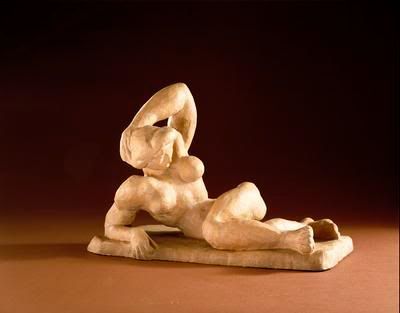
The two masterpieces that we would rescue from the Hirshhorn Museum and Sculpture Garden in Washington, DC before the meteorite hits and destroys the museum are “Reclining Nude I” and “Study of Portrait of Van Gogh III”. We selected the “Reclining Nude I” by Henri Matisse, in 1907, for its use of terra cota as the medium and the strong depiction of the female form. This sculpture symbolizes woman and her strength in body and soul to endure life and its many hardships. This is seen by the way Matisse sculpted the figure in a muscular form. Muscles usually symbolize strength. Therefore, one can assume that this woman is strong in character. Strength has normally been a characteristic associated with males. We also chose it for the strange way that the female figure is posed and the artist technique of rounding the breast and strong muscular features of the arms and hips. This type of pose is considered a “contrapposto, meaning counterpoise or counterbalance, which sets the body in a gentle S-shaped curve through a play of opposites” and if one was to stand over this piece, they would see the S-shape. (pg 279) Matisse use of monochromatic harmonies in this artwork brought out different aspects of the posed body, by using the rich cream color. This beautiful sculpture also represents a three dimensional space, as you follow the contours of the right arm, alongside the upper torso, around to the back of the sculpture. You are drawn right away to the upper torso, with the arm relaxed behind the head, giving emphasis to the perfectly rounded breasts. The next thing you notice is the chiseled physic of the female figure, which is unusual for a female. Matisse also tried to capture a more feminine look with the French hairstyle, creating a softer look around the facial features.

We selected to save the strange but interesting masterpiece by Francis Bacon, titled “Study for “Portrait of Van Gogh III”, in 1957, for an entirely different reason from why we chose the “Reclining Nude I”. We chose to save Bacon’s masterpiece because of the artist use of multiple mediums, oil paint and sand on linen, creating a grainy texture to the surface of the cloth. In addition, Bacon used brushstrokes which were bold and thick creating a layered surface which stands out in the art piece. To accomplish this effect, he used the technique called “impasto”. “Impasto is from the Italian for “paste”, a thick application of paint”. (pg 175) This created a landscape surface which appears to be smooth as well as rough in certain areas. The artist also used two different directional patterns in the foreground and background, giving the painting a distorted look. The stark contrast of the trees and male figure brings emphasis to the subject of Van Gogh, as a lonely figure walking along the road of life. This is also a great piece of art to be saved for future generations to aspire, with its use of vivid colors in his representation of the landscape. Bacon uses primary and secondary colors: red, yellow and green, to create a colorful composition with combination of blue representing the darkness of the sky.
In conclusion, these two wonderful masterpieces by Henri Matisse and Francis Bacon, were the only two that we would select to rescue from this terrible disaster at the museum, they really appealed to our sense of art design. The different mediums and techniques for both artworks allowed us to understand the subject of both pieces and detail the difference in design elements. The sculpture and the painting were both a thing of beauty to behold; artworks we would like to have in our homes.
No comments:
Post a Comment